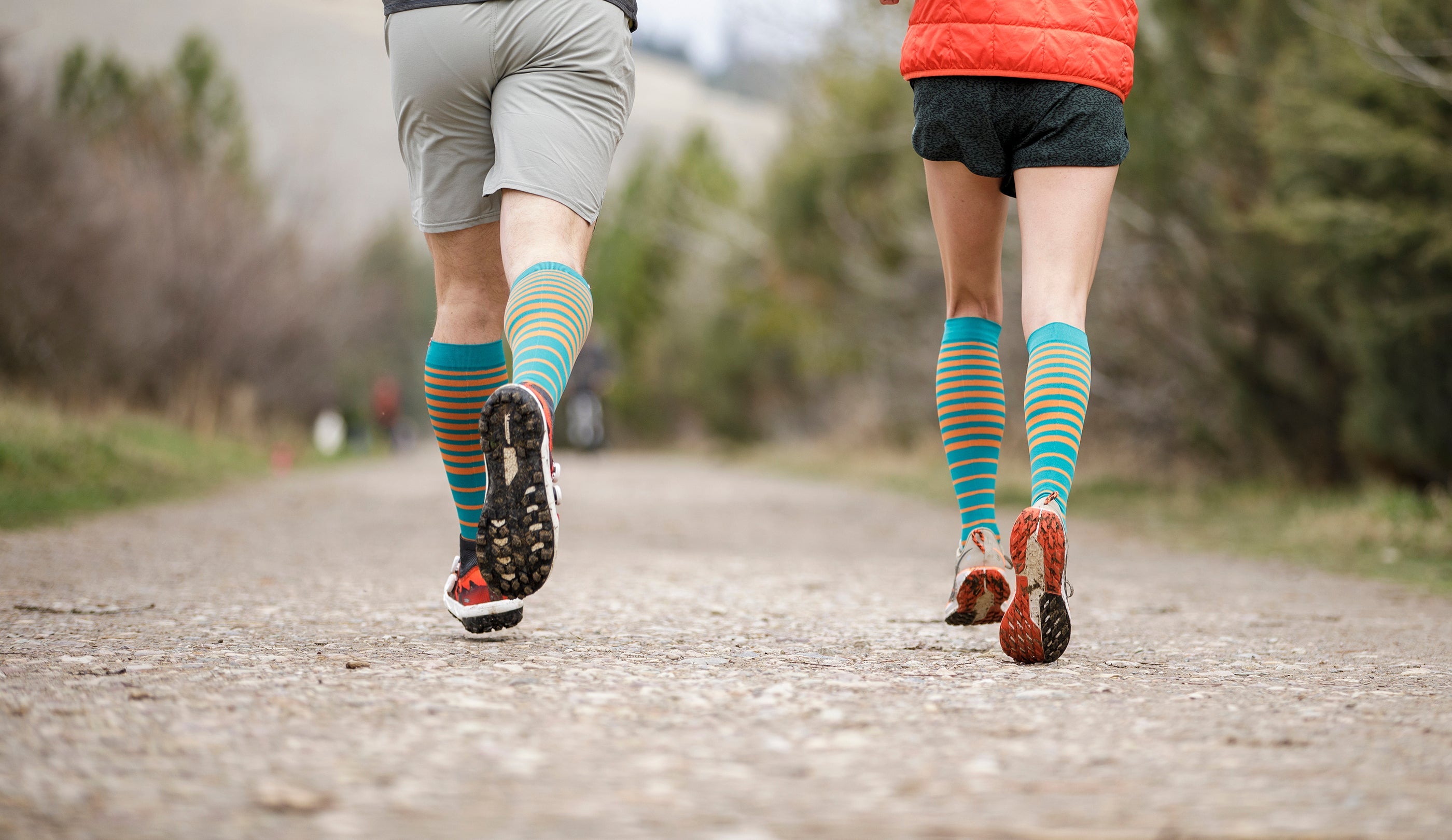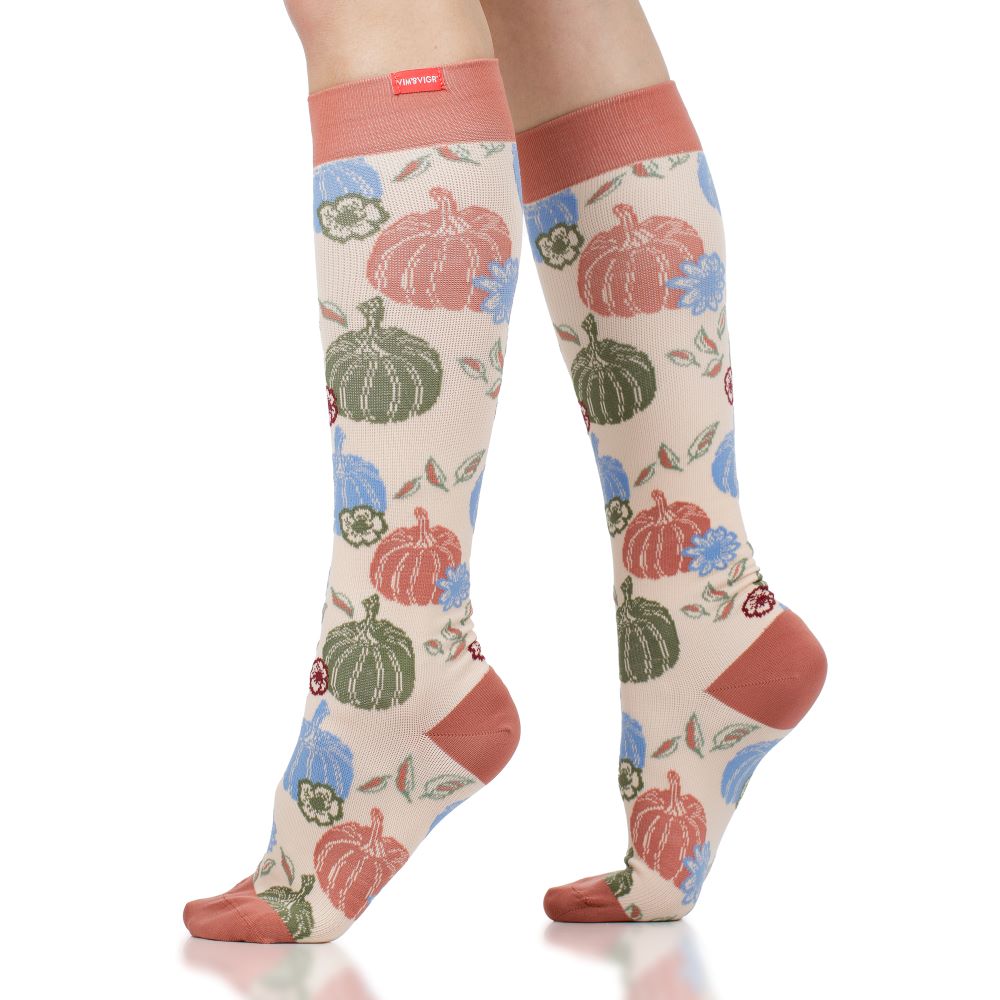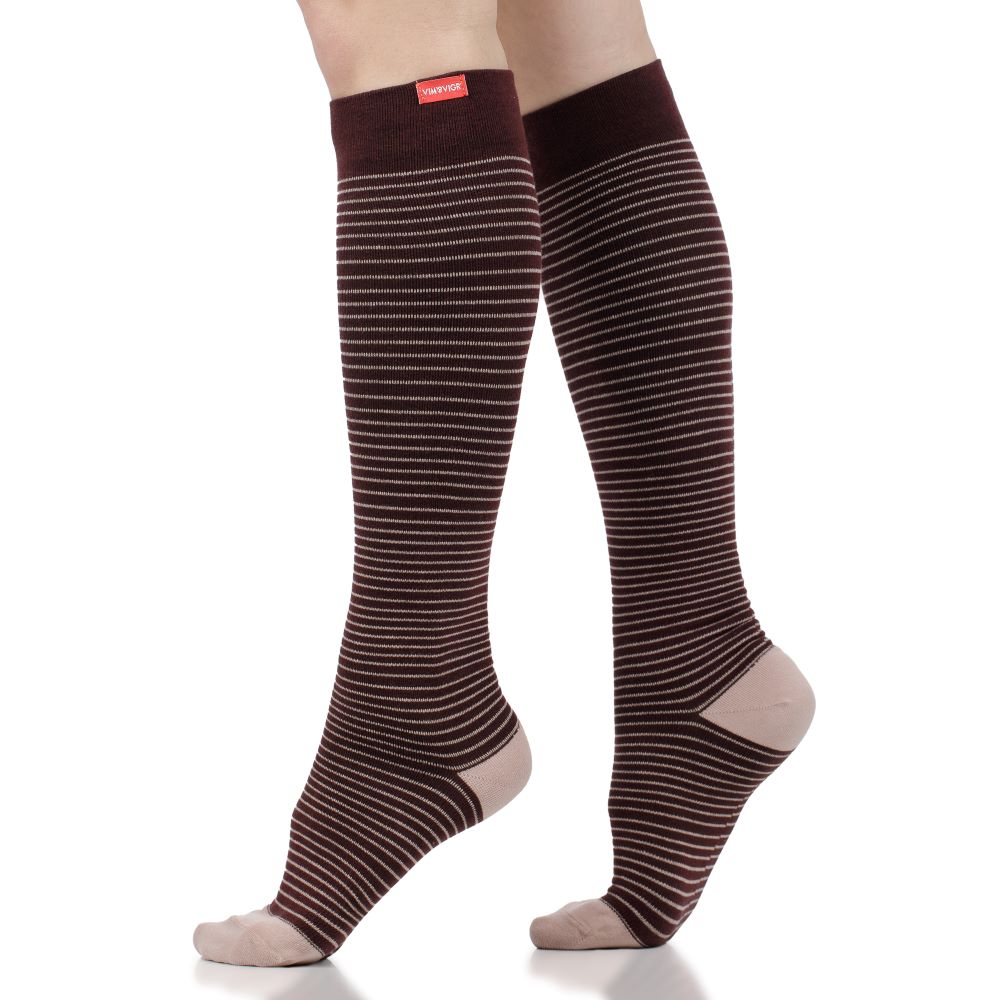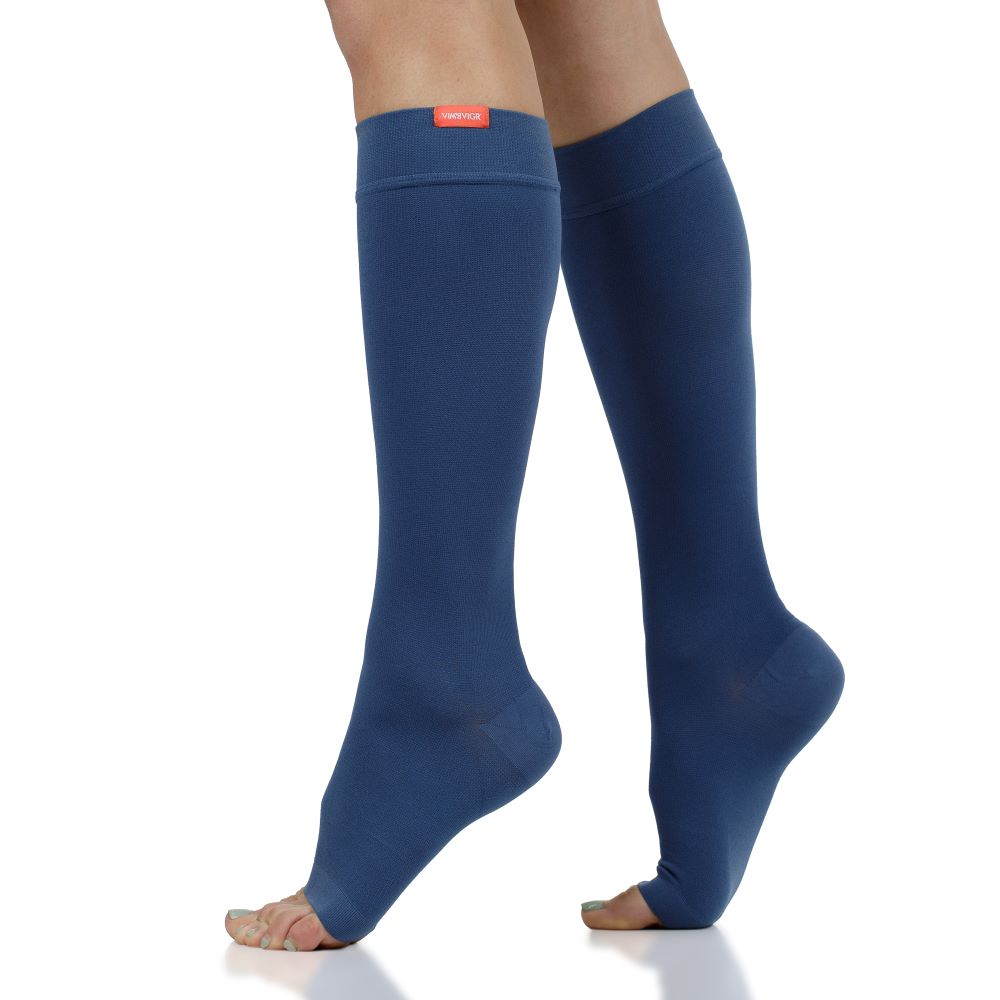10 Reasons Why Your Legs Feel Heavy + How to Get Relief
Written By Alecsa Stewart
Scientifically Reviewed by Daniel Chantigian
After a long day on your feet, it is common to feel discomfort, aches, and swelling in the legs, especially if you have peripheral circulation problems. You may find yourself wondering, “Why do my legs feel heavy?” if you run a lot without cooling down properly or if you have developed health conditions like edema or varicose veins. Well, there are many causes of heavy legs.
In this blog, you will learn the top 10 reasons why your legs feel heavy and some remedies you can try to relieve heavy legs. Read on to discover how to soothe your aching legs!
Why Do My Legs Feel Heavy?
Some reasons for heavy legs are linked to health conditions. Heavy legs could also simply be caused by situations like swelling after long days of travel or sitting all day. Here are the top 10 causes of heavy legs.
1. Varicose Veins
The feeling of heavy legs is frequently experienced by varicose vein patients, and pain and swelling are common. If your blood vessels have become damaged, blood can pool in the lower extremities, putting pressure on the veins, creating pain and “heaviness,” according to a scientific report. You may also notice a form of edema (swelling) if you have varicose veins.
Varicose veins can be identified as bluish, sometimes bulging veins that start to become obvious just under the skin. According to the Mayo Clinic, feelings of burning and itchiness are also common if you have varicose veins.

2. Prolonged Standing or Sitting
Many people sit or stand all day because of their work (like nurses, hairdressers, surgeons, and more). You may often feel like you need to shift your legs, which could be because of the fluid building up in your legs. If you are sitting or standing too long, your blood does not flow effectively from the legs back to the heart. This is known to cause feelings of heavy legs because you have more fluid in them than usual!
3. Chronic Venous Insufficiency
Chronic venous insufficiency is a medical condition associated with heavy legs. Researchers reported that having frequent feelings of “heavy legs” is an early sign of vascular diseases like chronic venous insufficiency. This is a condition where leg veins are damaged or are not working well, which does not allow blood to travel back to the heart like normal. As a result, blood pools in the lower legs leading to swelling, aching, and inflammation, which can result in feelings of tired or heavy legs.
There are connections between chronic venous insufficiency, varicose veins, edema, and other circulatory problems. To help you improve your heavy legs, graduated compression socks can help stimulate blood flow out of the legs thanks to the therapeutic pressure they apply. Graduated compression socks can be an effective tool in managing chronic venous insufficiency and reducing the impact of its symptoms.
4. Peripheral Artery Disease
Peripheral Artery Disease (PAD) affects blood flow in the extremities. It occurs when blood vessels narrow because of fatty plaque build-up in the arteries, known as atherosclerosis. PAD often leads to pain and discomfort in the legs, feelings of heaviness, and can lead to complications like muscle atrophy (pain with exercise makes people with PAD less likely to be active) and others.
If you suffer from PAD, you may find compression therapy beneficial for boosting peripheral circulation, especially in the early stages of PAD. PAD has been reported to cause other vein problems like varicose veins or even venous ulcers. Some studies found that graduated compression helps relieve symptoms of varicose veins and venous ulcers. However, you should consult with a doctor before seeking any at-home remedies.
5. Edema
The medical term for when fluid builds up in the body, causing localized swelling, is edema. In the legs, it is common to have lymphedema (where lymphatic fluid pools in the extremities) or edema caused by blood pooling, typically around the ankles. This leads to swelling that causes legs to feel heavy and uncomfortable.
Edema patients might benefit from leg massages, which could boost circulation and move fluid out from the lower legs. Graduated compression socks can also offer relief for heavy legs by massaging the legs and pushing blood and fluid up from the ankles.

6. Overexertion and Muscle Fatigue
Another common reason you may ask yourself, “why do my legs feel heavy?” is simply fatigue. Runners and athletes of all kinds report feeling heavy-legged when they start a session without sufficient rest and recovery, which could be a sign of overtraining syndrome. Heavy legs can also happen after an exercise session if you had increased the intensity or frequency of your workouts in the gym.
What is best to do in these situations? For some, an extra day of rest can work wonders. Wearing compression socks and lying down with the legs elevated above the heart will boost blood flow, helping nutrients and oxygen get to the muscles. Research has also found that compression socks may improve recovery speeds. If you are looking for active recovery, a gentle cross-training activity like light swimming or cycling helps blood circulation and loosens tight muscles. Listen to your body, stretch, and never neglect a rest day!
7. Pregnancy
Pregnancy often leads to heavy legs because of increases in swelling in the feet and ankles. This is caused by increased pressure on the blood vessels from the added volume of blood moving through the body. If you are pregnant, you may also experience water retention and fatigue, leading to a feeling of heaviness overall.
8. Lifestyle
People with an unhealthy lifestyle are more likely to have circulatory problems. This includes people who do not exercise, frequently eat processed or salty food, smoke, and consume alcohol. These all have negative effects on vein health and blood pressure. Retaining water can be due to a salty diet, for example, which also causes blood to thicken. Additionally, movement improves blood flow, which energizes the legs and helps flush out excess fluid and keep blood moving throughout the body.
Some lifestyle changes you can make if you suffer from heavy legs regularly include taking up a physical activity such as walking or swimming, changing diets to include more fresh fruits and vegetables and fewer processed and salty foods, increasing hydration levels, giving up smoking, and reducing alcohol consumption.
9. Obesity
The UK National Health Service lists being obesity as a common cause of edema and feelings of heaviness in the legs. When more pressure is placed on the blood vessels by extra weight, the vessels can also weaken over time, which leads to blood clots and other circulatory problems. This further aggravates the swelling and heaviness you feel. Reducing unhealthy foods and focusing on exercising can make an enormous difference in these cases to improve vascular health and reduce excess weight.
10. Other Medical Conditions and Certain Medications
Sometimes, feelings of heavy legs can be caused by injury - like a sprain or a strain. In some cases, edema and heavy legs are caused by certain medical conditions like kidney, liver, or heart diseases. If you experience unusual swelling that does not go away, you should speak to a doctor right away.
Finally, heavy legs may be the result of medication for blood pressure, of birth control pills, hormone therapy, antidepressants, or steroids. Consult with a medical professional if you are experiencing uncomfortable swelling and are taking any of these.
Finding Relief for Heavy Legs
Depending on the reason for your heavy legs, you may be able to find relief naturally, at home. Here are common remedies for heavy legs, swelling, and discomfort.
Elevation
Lifting the legs above the heart level may help blood flow back towards the heart. This can, according to one study, relieve pressure in the lower legs and bring down inflammation and swelling. You can combine elevation and compression therapy for extra effectiveness.
Compression Stockings
Wear graduated compression stockings or socks to support vein health and boost upwards blood flow. The way these socks are designed means they are tighter towards the ankles, loosening up gradually towards the knees, which helps move blood and fluid from the periphery. Compression socks are known to reduce feelings of heavy legs as well as swelling and inflammation. Compression also helps prevent legs from swelling in the first place, which is why we recommend wearing compression socks on long travel days or if spending all day on your feet at work.

Regular Exercise and Stretching
Regularly working out helps maintain a healthy cardiovascular system and blood flow. It does not need to be a huge amount of exercise all at once. Medical researchers recommend at least 150 minutes of moderate intensity exercise is to improve circulation and overall health. You could take regular walks, perform gentle exercise like yoga or Pilates, or stretch. Regular exercise can reduce heavy legs and prevent discomfort in the future.
Hydration and Balanced Diet
Too much salt in the diet can lead to water retention and thickening of the blood, which causes blockages in the lower extremities. As a result, you can experience feelings of heaviness, pain, numbness, and/or tingling feet. To avoid this, eat a balanced diet with lots of fresh fruits and vegetables and minimize your intake of heavily processed or salty foods. Proper hydration also helps - so ensure you drink enough water throughout the day.
Weight Management
People who are significantly overweight place added pressure on their circulation system, which can cause the blood vessels to weaken. Weak blood vessels can lead to blood clots, varicose veins, and other circulatory problems where heavy legs and pain are common symptoms. Maintain a healthy weight through exercise and a balanced diet to avoid heavy legs and other health problems. If you already suffer from lower leg edema and chronic heavy legs, speak to your doctor to see what the best steps are for your situation.
Stop Smoking
Smoking is very detrimental to your heart and blood vessels. According to the National Heart, Lung, and Blood Institute, the chemicals you inhale when you smoke makes you more likely to develop atherosclerosis, which can lead to peripheral artery disease. Even before that, any amount of smoking weakens the blood vessels, leading to swelling, discomfort, and heavy legs, and to more serious health problems in the longer term.
When to See Your Doctor
If you are experiencing any of the symptoms below, you should seek medical attention as soon as possible:
- Your swelling hasn’t resolved after two days.
- The swelling is only on one side and there is no obvious cause or injury (e.g., no ankle sprain)
- Your swelling started very suddenly and is severe and very sore.
- You have a fever and chills.
- You have diabetes.
If you are seeing a new doctor who doesn’t know your medical history, make sure you tell them if you have traveled recently, had any recent surgery or have any heart condition, and point out any skin changes on the affected limb. This will help them decide which tests to order to find the cause of your swelling and heavy-legged feeling.
If you have chronic or persistent edema, seek medical attention. Chronic edema is progressive and can lead to conditions from infection to chronic disability. Outcomes are far better when the underlying disease is identified in its early stages, so work with your doctor to find the right treatment.
The UK NHS points to several symptoms that indicate an acute medical emergency: if you notice swelling in your leg and you feel short of breath, your chest feels tight or painful, and/or you are struggling to breathe. You may have a blood clot that has traveled from the deep veins in your calf to your lungs (DVT). Call for urgent medical attention straight away.
References
InformedHealth.org [Internet]. Cologne, Germany: Institute for Quality and Efficiency in Health Care (IQWiG); 2006-. Varicose veins: Overview. 2008 Feb 20 [Updated 2019 Sep 25]. Read it here.
Mayo Clinic Staff. (2024). Varicose Veins. Mayo Clinic. Read it here.
Waters, T. R., & Dick, R. B. (2015). Evidence of health risks associated with prolonged standing at work and intervention effectiveness. Rehabilitation nursing: the official journal of the Association of Rehabilitation Nurses, 40(3), 148–165. Read it here.
Pinto, P. C., & Rodrigues, L. M. (2009). An experimental in vivo model to characterize "heavy legs" symptom in topical formulations. Dermatology research and practice, 2009, 547039. Read it here.
Lim, C. S., & Davies, A. H. (2014). Graduated compression stockings. CMAJ : Canadian Medical Association journal = journal de l'Association medicale canadienne, 186(10), E391–E398. Read it here.
Center for Disease Control & Prevention. (2024). About Peripheral Arterial Disease. Read it here.
Gul, F., & Janxer, S.F. (2023). Peripheral Vascular Disease. StatPearls Publishing. Read it here.
Knight Nee Shingler, S. L., Robertson, L., & Stewart, M. (2021). Graduated compression stockings for the initial treatment of varicose veins in people without venous ulceration. The Cochrane database of systematic reviews, 7(7). Read it here.
Kreher, J. B., & Schwartz, J. B. (2012). Overtraining syndrome: a practical guide. Sports health, 4(2), 128–138. Read it here.
Mota, G. R., Simim, M. A. M., Dos Santos, I. A., Sasaki, J. E., & Marocolo, M. (2020). Effects of Wearing Compression Stockings on Exercise Performance and Associated Indicators: A Systematic Review. Open access journal of sports medicine, 11, 29–42. Read it here.
Chen, Y. L., Cheng, Y. T., Ye, J. N., Huang, T. L., & Chen, W. N. (2020). Posture and Time Arrangement Influence Shank Circumference Reduction When Performing Leg Raising Exercise. International journal of environmental research and public health, 17(16), 5735. Read it here.
Singh, R., Pattisapu, A., & Emery, M. S. (2020). US Physical Activity Guidelines: Current state, impact and future directions. Trends in cardiovascular medicine, 30(7), 407–412. Read it here.
Keast, D. H., Despatis, M., Allen, J. O., & Brassard, A. (2015). Chronic oedema/lymphoedema: under-recognised and under-treated. International wound journal, 12(3), 328–333. Read it here.


















Leave a comment